
Contents










Story · Written by Park Jina Photographed by Studio Kenn
From Periphery to
Center
Gyeonggi-do Province cuts through the Korean Peninsula and embraces Seoul and the Hangang River.
Named Hyeonjong at the time of the Goryeo Kingdom (918-1392), the province had as its capital Gaegyeong and
13 surrounding hyeon (an administrative subdivision) in 1018, which is when the region got its name “Gyeonggi.”
Gyeonggi-do drastically changed over the past millennium, assuming various roles as a key position surrounding the capital.
Before Korea’s modern era, the province was a guard post protecting
the capital and in modern times, it grew as a new city sharing the capital’s roles.
Hwaseong Fortress, a leading landmark of Suwon, was the first planned city of King Jeongjo, the 22nd monarch of the Joseon Dynasty (1392-1910), built to realize his grand vision for reform. The fortress was also part of his political aspiration to uproot partisan politics arising from factional strife and rule under the principles of royalty.
Walking along the fortress after leaving Seojangdae will reveal the remarkable beauty of the fortress wall, which was built by skillfully crossing stones and bricks. Embracing the broad urban districts and stretching along the foothills and crests of Paldalsan Mountain, the wall is elegant and dignified. The fortress was also the first to be built with bricks.
One figure is always mentioned whenever the fortress is discussed: Jeong Yak-yong. A leading Joseon master of Silhak (Practical Learning), he joined the fortress’s construction under King Jeongjo’s order, developed the apparatus geojunggi using the principle of pulleys and utilized it to build the fortress wall. The adoption of elaborate plans and advanced technology shortened the fortification period and curtailed the public’s burden. Walking along the fortress wall from Seojangdae leads to Hwaseomun Gate, where a one-story tower designed by Jeong was built on an arched gate linked to the fortress wall. The west gate of the fortress has a semicircular outer wall made of bricks on its front. When war broke out, soldiers protected the gate by deterring the enemy with arrows.
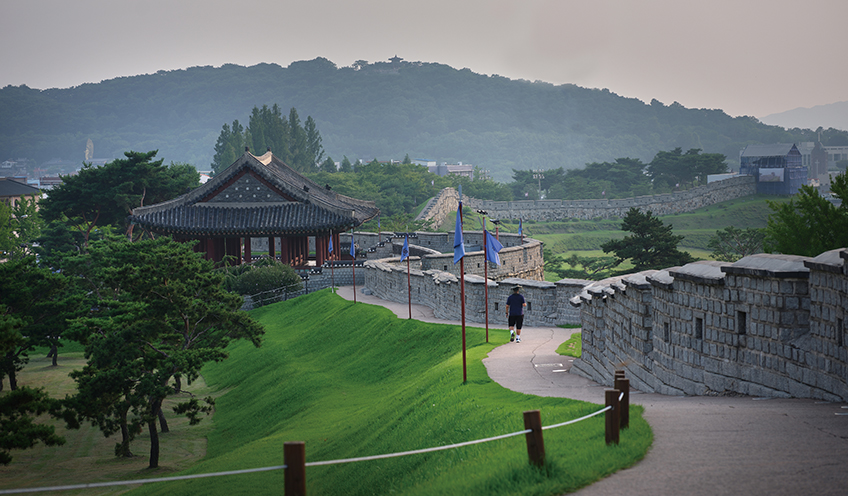
The winding road along Hwaseong Fortress in Suwon offers travelers a scenic view.
Delving inside of the fortress a little deeper leads to a street of handicraft workshops from Paldalmun Gate, the fortress’s south gate, to Haenggung, or temporary palace. Called the “Insa-dong of Suwon,” the street romantically synthesizes the past and present through artworks that stop passersby in their tracks. A variety of designers and artists mingle for prosperity. Could this have been what King Jeongjo had in mind as an ideal city while planning the fortress, a society where all are happy together? This is the creation of the first new city King Jeongjo dreamed of.
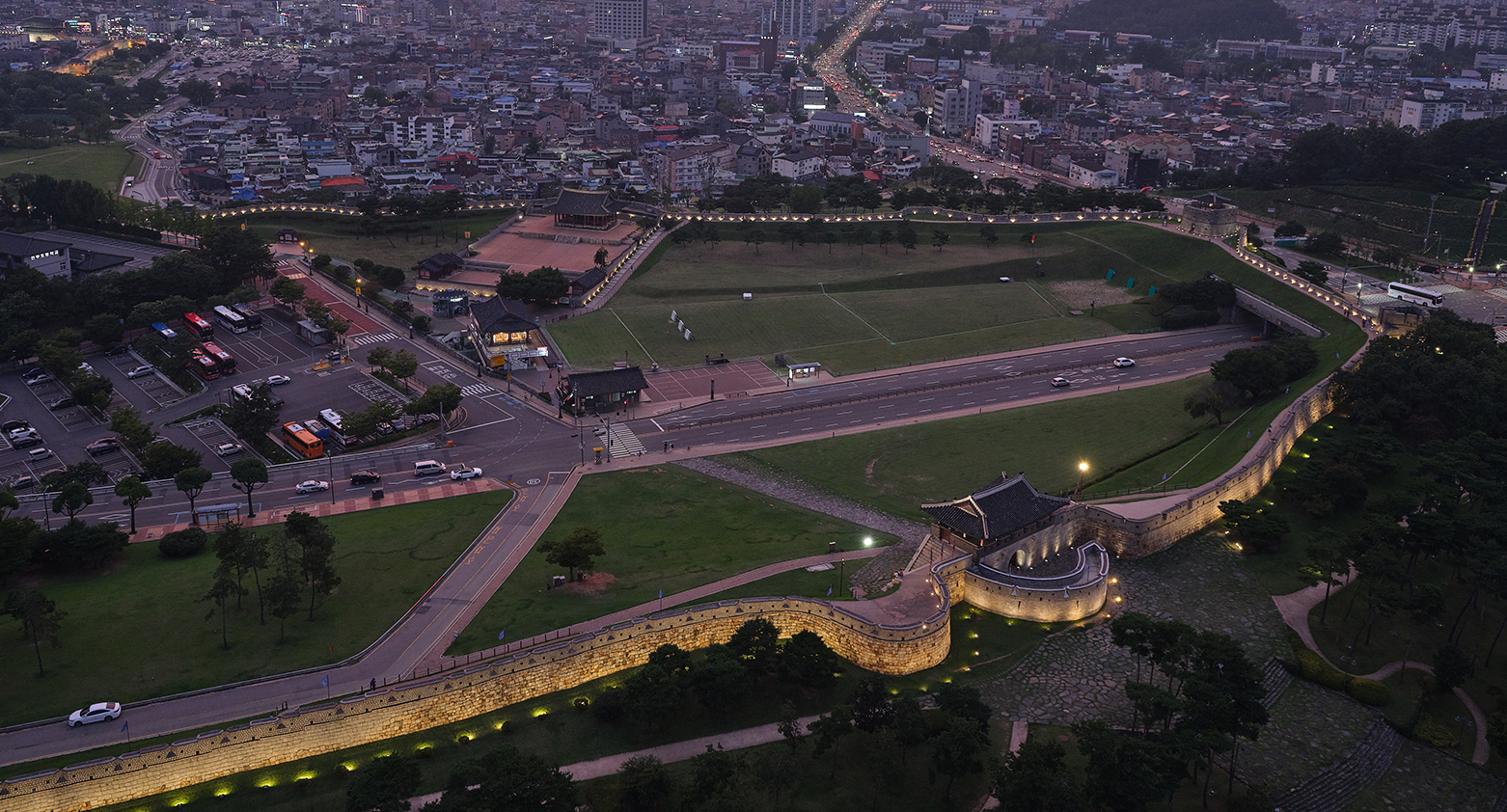
Seongnam: Hub of Cutting-edge Industries
Bundang-gu District of Seongnam, Gyeonggi-do Province, which is adjacent to Suwon, is a planned city developed by government policy to alleviate the excessive population concentration in Seoul. Those flocking to Seongnam lured by the population decentralization policy came to foster industries different from those in Seoul, and innovative high-tech startups from a variety of fields moved there. Represented by Bundang-gu and Pangyo, a region within Seongnam that comprises several neighborhoods, the Seoul suburb is home to leading domestic companies including the web portal site Naver, video game giant Nexon and cyber security pioneer AhnLab. This makes Seongnam the hub of the national information and communications technology (ICT) sector.
Employees flood the streets during rush hour and the glow of headlights brighten up a road, and people can stroll through the city’s forest of buildings in step with the lively and dynamic scenery. As if to take pride in being the national hub of cutting-edge ICT and R&D, office workers are often seen wearing casual attire instead of suits. Discovering familiar logos inscribed on buildings is another way to enjoy the city.

Nicknamed the “Silicon Valley of Korea,” the Pangyo area of Seongnam houses leading domestic companies in information and communications technology and the bio industry, with many workers dressed in casual attire.
Living up to its reputation as a mecca for high-tech leaders, Seongnam sports buildings that go beyond stereotypes with each showing their a unique identity. Cha Bio Complex, whose design was partially done by the late Italian architect Alessandro Mendini, shows off a riot of colors and mild curves to resemble the headquarters of a bio industry leader. Green Factory, the home of Naver, also proudly displays its identity through a green façade, reflecting the color of the Korean internet giant.
The forest turns into something completely different when entering it. Instead of appearing listless because of a skyline dominated by high-rise buildings, Seongnam has instead grown into a futuristic tech city full of uniqueness and vitality thanks to the convergence of leaders of the Fourth Industrial Revolution.
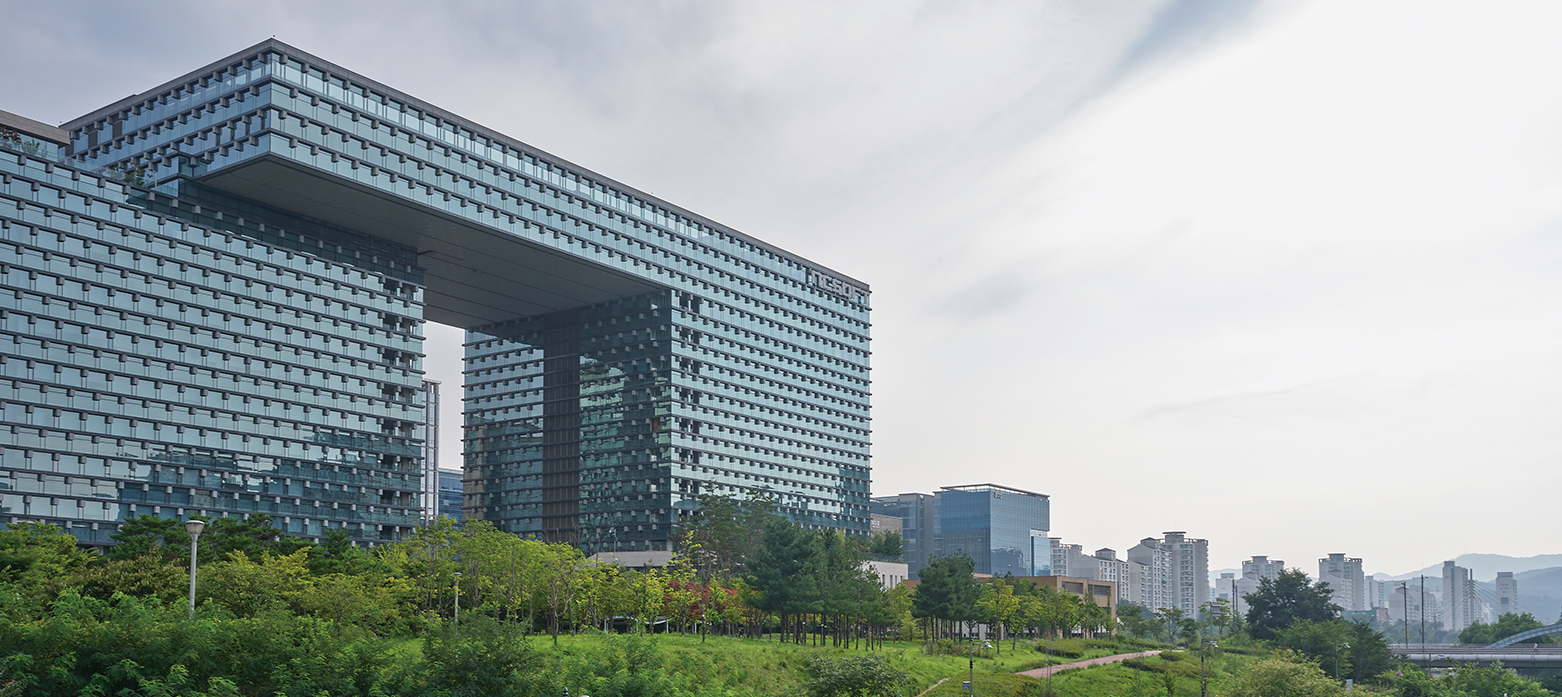
Pangyo Techno Valley is Home to leading domestic companies.
Gwangmyeong:
Coexistence of Travel and Routine
The next destination after Seongnam is Gwangmyeong, which has recently grabbed the spotlight. This suburb is a major transportation hub thanks to the KTX station connecting Seoul to the provinces, as well as a city air terminal connected to Incheon International Airport. This could explain why the scale of Gwangmyeong Station is greater than thought. More recently, the city has become known for shopping as a variety of shopping malls like Lotte Outlets, Ikea and Costco have opened up around the station.
The station’s towering arch-shaped roof does not have even a single pillar and the gently falling curves embody the eaves of a traditional Korean house and its curved lines. People traveling through the station and incoming and outgoing trains are featured like panorama scene due to the transparent glass walls. The station could also serve as the starting point for an inter- Korean railway thanks to its near-perfect conditions to become an international rail station.

Gwangmyeong Station is a major transportation hub thanks to a KTX station there connecting the city to the provinces, as well as a city air terminal linked to Incheon International Airport. © getty images korea
Paju: Frontline of Arts and Peace
Paju, a border city located close to the Demilitarized Zone separating the two Koreas on the northern tip of Gyeonggi-do, has undergone a transformation from a place synonymous with national security into a city of humanities. Korea’s sole complex for the cultural industry, Paju Book City, has around 400 publication-related entities including publishing and printing houses and design and distribution companies. Its collaborative system is hard to find elsewhere around the world.
This complex was also created through meticulous planning. Built in collaboration with publishers and architects, it has buildings each with its own unique characteristics that collectively form a cohesive unit. This is thanks to meticulously controlling the size and placement of buildings and materials and considering harmony with existing ecosystems and neighboring structures.
An eye-catching feature of Paju Book City is Mimesis Art Museum with its beautiful curves. The appearance of several spaces of diverse sizes being integrated into one cluster is a microcosm of Gyeonggi-do, a province made more attractive through the addition of each new city.
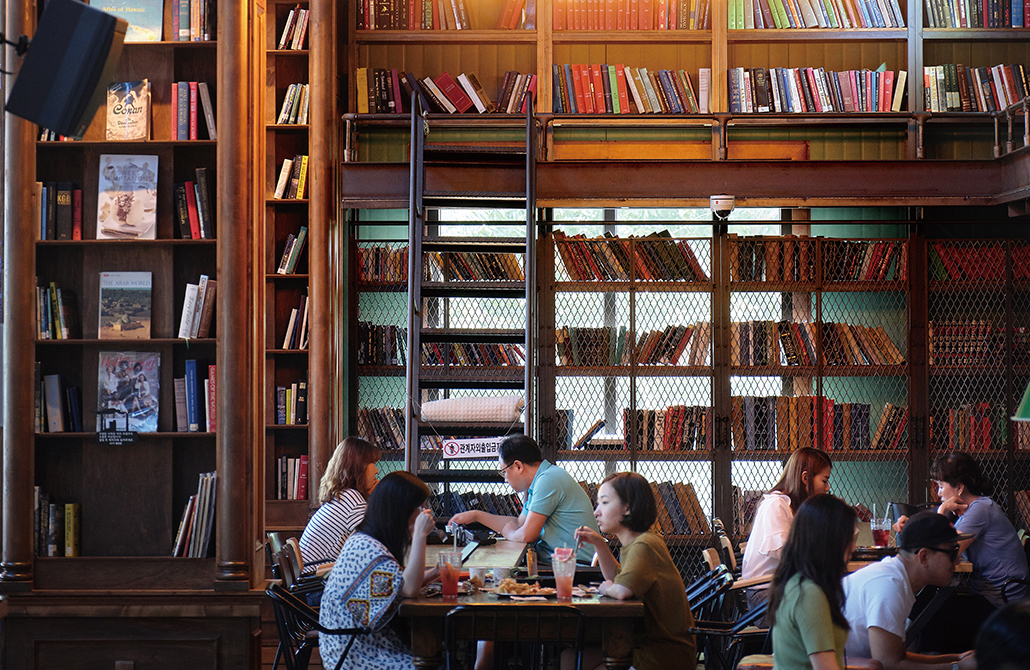
Around half of all publications produced in Korea come from Paju.
Walk along the river for 30 minutes from Paju Book City to reach Imjingak Pyeonghwa Nuri Park, the country’s northernmost tourist spot where visitors can get a glimpse into North Korea. This place had previously been a favorite of former North Korean defectors who visited in droves to gaze at their hometowns, albeit from a distance. The opening of the park now has attracted families and couples on dates.
Cities in the province, with a diversity of narratives and unique sentiments, started off as satellite cities intended to disperse the population and industries concentrated in the capital but each city has developed its own culture, industry and infrastructure to stand on its own. Thus Gyeonggi-do’s charm lies in the assortment of its new cities each developing its own distinct flavor while forming a unique collective.
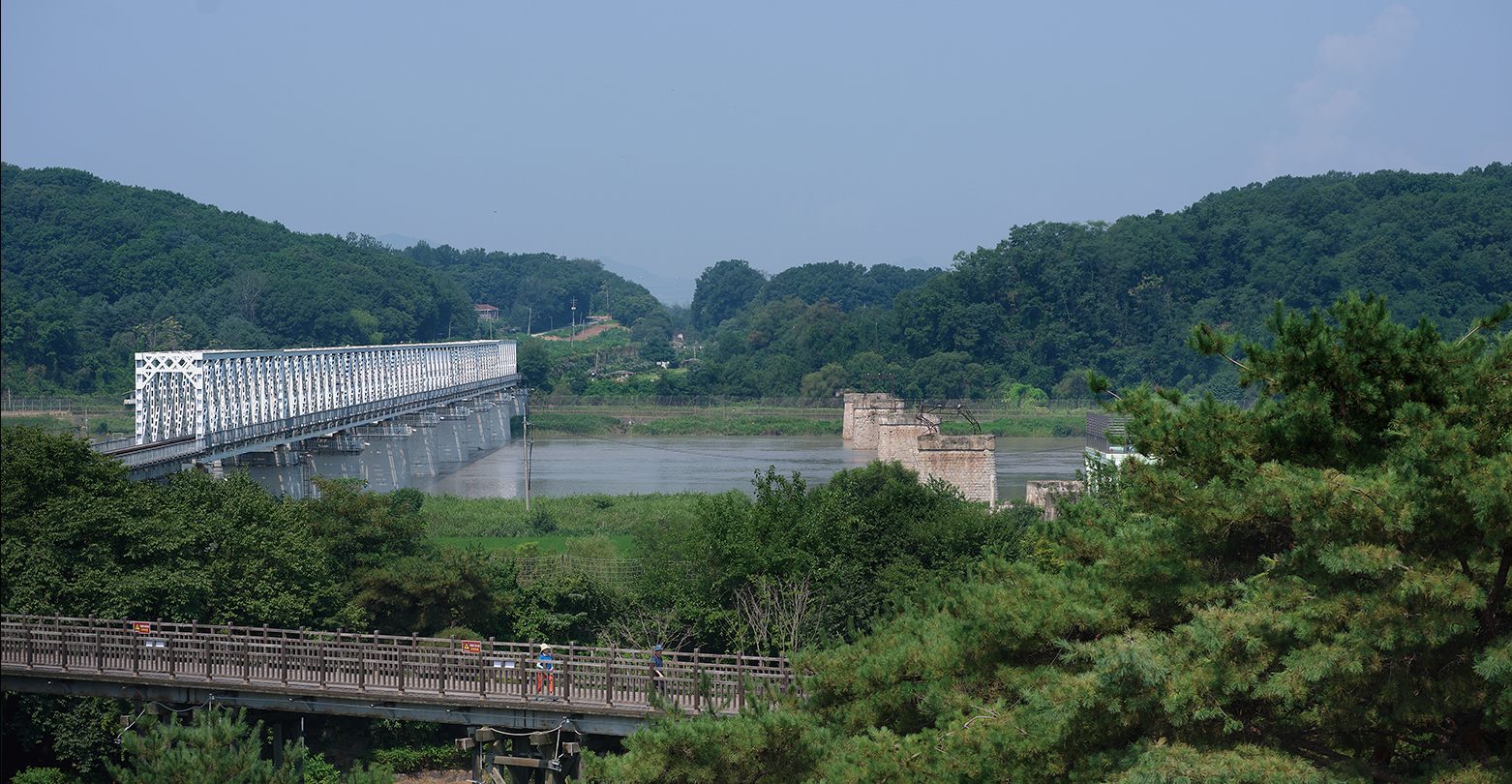
The Bridge of Freedom going across the Imjingang River in Paju is where 13,000 prisoners of war were exchanged during the Korean War.
More about Gyeonggi-do Province ⟶
Other Articles















